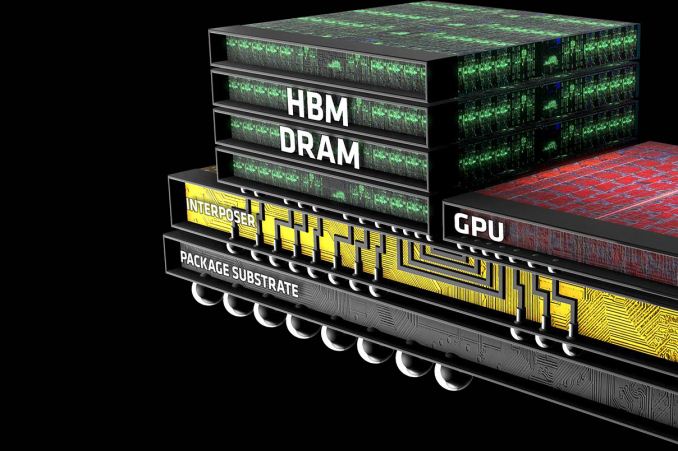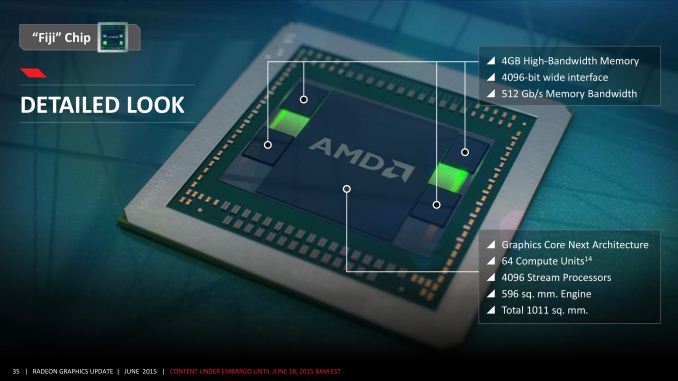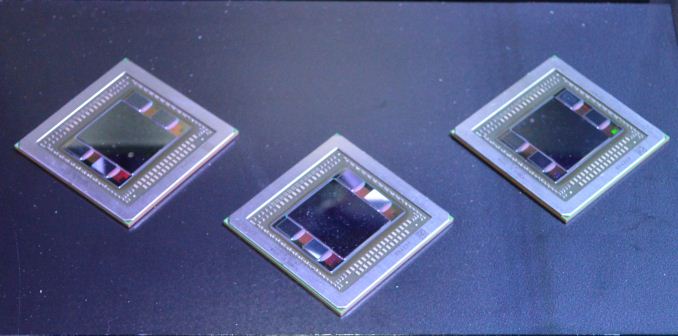The AMD Radeon R9 Fury X Review: Aiming For the Top
by Ryan Smith on July 2, 2015 11:15 AM ESTThe Fiji GPU: Go Big or Go Home
Now that we’ve had a chance to take a look at the architecture backing Fiji, let’s talk about the Fiji GPU itself.
Fiji’s inclusion of High Bandwidth Memory (HBM) technology complicates the picture somewhat when talking about GPUs. Whereas past GPUs were defined by the GPU die itself and then the organic substrate package it sits on, the inclusion of HBM requires a third layer, the silicon interposer. The job of the interposer is to sit between the package and the GPU, serving as the layer that connects the on-package HBM memory stacks with the GPU. Essentially a very large chip without any expensive logic on it, the silicon interposer allows for finer, denser signal routing than organic packaging is capable of, making the ultra-wide 4096-bit HBM bus viable for the first time.
We’ll get to HBM in detail in a bit, but it’s important to call out the impact of HBM and the interposer early, since they have a distinct impact on how Fiji was designed and what its capabilities are.
As for Fiji itself, Fiji is unlike any GPU built before by AMD, and not only due to the use of HBM. More than anything else, it’s simply huge, 596mm2 to be precise. As we mentioned in our introduction, AMD has traditionally shied away from big chips, even after the “small die” era ended, and for good reason. Big chips are expensive to develop, expensive to produce, take longer to develop, and yield worse than small chips (this being especially the case early-on for 40nm). Altogether they’re riskier than smaller chips, and while there are times where they are necessary, AMD has never reached this point until now.
The end result is that for the first time since the unified shader era began, AMD has gone toe-to-toe with NVIDIA on die size. Fiji’s 596mm2 die size is just 5mm2 (<1%) smaller than NVIDIA’s GM200, and more notably still hits TSMC’s 28nm reticle limit. TSMC can’t build chips any bigger than this; Fiji is as big a chip as AMD can order.
| AMD Big GPUs | ||||
| Die Size | Native FP64 Rate | |||
| Fiji (GCN 1.2) | 596mm2 | 1/16 | ||
| Hawaii (GCN 1.1) | 438mm2 | 1/2 | ||
| Tahiti (GCN 1.0) | 352mm2 | 1/4 | ||
| Cayman (VLIW4) | 389mm2 | 1/4 | ||
| Cypress (VLIW5) | 334mm2 | 1/5 | ||
| RV790 (VLIW5) | 282mm2 | N/A | ||
Looking at Fiji relative to AMD’s other big GPUs, it becomes very clear very quickly just how significant this change is for AMD. When Hawaii was released in 2013 at 438mm2, it was already AMD’s biggest GPU ever for its time. And yet Fiji dwarfs it, coming in at 158mm2 (36%) larger. The fact that Fiji comes at the latter-half of the 28nm process’s life time means that such a large GPU is not nearly as risky now as it would have been in 2011/2012 (NVIDIA surely took some licks internally on GK110), but still, nothing else we can show you today can really sell the significance of Fiji to AMD as much as the die size can.
And the fun doesn’t stop there. Along with producing the biggest die they could, AMD has also more or less gone the direction of NVIDIA and Maxwell in the case of Fiji, building what is unambiguously the most gaming/FP32-centric GPU the company could build. With GCN supporting power-of-two FP64 rates between 1/2 and 1/16, AMD has gone for the bare minimum in FP64 performance that their architecture allows, leading to a 1/16 FP64 rate on Fiji. This is a significant departure from Hawaii, which implemented native support for ½ rate, and on consumer parts offered a handicapped 1/8 rate. Fiji will not be a FP64 powerhouse – its 4GB of VRAM is already perhaps too large of a handicap for the HPC market – so instead we get AMD’s best FP32 GPU going against NVIDIA’s best FP32 GPU.
AMD’s final ace up their sleeve on die size is HBM. Along with HBM’s bandwidth and power benefits, HBM is also much simpler to implement, requiring less GPU space for PHYs than GDDR5 does. This is in part due to the fact that HBM stacks have their own logic layer, distributing some of the logic on to each stack, and furthermore a benefit of the fact that the signaling logic that remains doesn’t have to be nearly as complex since the frequencies are so much lower. 4096-bits of HBM PHYs still takes up a fair bit of space – though AMD won’t tell us how much – but it’s notably lower than the amount of space AMD was losing to Hawaii’s GDDR5 memory controllers.
The end result is that not only has AMD built their biggest GPU ever, but they have done virtually everything they can to maximize the amount of die space they get to allocate to FP32 and rendering resources. Simply put, AMD has never reached so high and aimed for parity with NVIDIA in this manner.
Ultimately this puts Fiji’s transistor count at 8.9 billion transistors, even more than the 8 billion transistors found in NVIDIA’s GM200, and, as expected, significantly more than Hawaii’s 6.2 billion. Interestingly enough, on a relative basis this is almost exactly the same increase we saw with Hawaii; Fiji packs in 43.5% more transistors than Hawaii, and Hawaii packed in 43.9% more transistors than Tahiti. So going by transistors alone, Fiji is very much to Hawaii what Hawaii was to Tahiti.
Finally, as large as the Fiji GPU is, the silicon interposer it sits on is even larger. The interposer measures 1011mm2, nearly twice the size of Fiji. Since Fiji and its HBM stacks need to fit on top of it, the interposer must be very large to do its job, and in the process it pushes its own limits. The actual interposer die is believed to exceed the reticle limit of the 65nm process AMD is using to have it built, and as a result the interposer is carefully constructed so that only the areas that need connectivity receive metal layers. This allows AMD to put down such a large interposer without actually needing a fab capable of reaching such a large reticle limit.
What’s interesting from a design perspective is that the interposer and everything on it is essentially the heart and soul of the GPU. There is plenty of power regulation circuitry on the organic package and even more on the board itself, but within the 1011mm2 floorplan of the interposer, all of Fiji’s logic and memory is located. By mobile standards it’s very nearly an SoC in and of itself; it needs little more than external power and I/O to operate.













458 Comments
View All Comments
Chaser - Friday, July 3, 2015 - link
Oh yeah that invalidated the entire review. /facepalmStrychn9ne - Saturday, July 4, 2015 - link
Great review here! It was a good read going through all the technical details of the card I must say. The Fury X is an awesome card for sure. I am trying to wait for next gen to buy a new card as my 280X is holding it's own for now, but this thing makes it tempting not to wait. As for the performance, I expect it will perform better with the next driver release. The performance is more than fine even now despite the few losses it had in the benches. I suspect that AMD kind of rushed the driver out for this thing and didn't get enough time to polish it fully. The scaling down to lower resolutions kind of points that way for me anyways.Peichen - Saturday, July 4, 2015 - link
AMD/ATI, what a fail. Over the past 15 years I have only gone Nvidia twice for 6600GT and 9800GT but now I am using a GTX 980. Not a single mid-range/high-end card in AMD/ATI's line up is correctly priced. Lower price by 15-20% to take into account the power usage, poor driver and less features will make them more competitivejust4U - Saturday, July 4, 2015 - link
At the high end you "may" have a point.. but what is the 960 bringing to the table against the 380? Not much.. not much at all. How about the 970 vs the 390? Again.. not much.. and in crossfire/sli situations the 390 (in theory..) should be one helluva bang for the buck 4k setup.There will be a market for the FuryX.. and considering the efforts they put into it I don't believe it's going to get the 15-20% price drop your hoping for.
TheinsanegamerN - Saturday, July 4, 2015 - link
Slightly better performance while pulling less power and putting out less heat, and in the 970's case, is currently about $10 cheaper. Given that crossfire is less reliable than SLI, why WOULD you buy an AMD card?Oxford Guy - Saturday, July 4, 2015 - link
Maybe because people want decent performance above 3.5 GB of VRAM? Or they don't appreciate bait and switch, being lied to (ROP count, VRAM speed, nothing about the partitioning in the specs, cache size).medi03 - Sunday, July 5, 2015 - link
Freesync?Built-in water cooling?
Disgust for nVidia's shitty buisness practices?
A brain?
chizow - Monday, July 6, 2015 - link
How do you feel about the business practice of sending out a card with faults that you claimed were fixed?Or claims that you had the world's fastest GPU enabled by HBM?
Or claims/benches that your card was faster than 980Ti?
Or claims that your card was an Overclocker's Dream when it is anything but that and OCs 10% max?
A brain right? :)
sa365 - Tuesday, July 7, 2015 - link
How do you feel about the business practice of sending out a card with faulty, cheating drivers that lower IQ despite what you set in game so you can win/cheat in those said benchmarks. It's supposed to be apples to apples not apples to mandarins?How about we wait until unwinder writes the software for voltage unlocks before we test overclocking, those darn fruits again huh?
Nvidia will cheat their way through anything it seems.
It's pretty damning when you look at screens side by side, no AF Nvidia.
Margalus - Monday, July 6, 2015 - link
freesync? not as good as gsync and is still not free. It takes similar hardware added to the monitor just like gsync.built in water cooling? just something else to go wrong and be more expensive to repair, with the possibility of it ruining other computer components.
Disgust for NVidia's shitty business practices? what are those? Do you mean like not giving review samples of your cards to honest review sites because they told the truth about their cards so now you are afraid that they will tell the truth about your newest pos? Sounds like you should really hate AMD's shitty business practices.